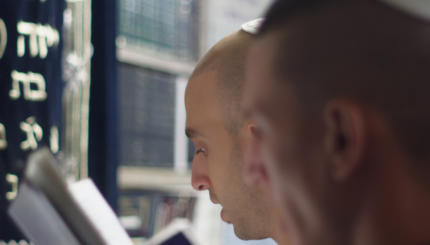Reprinted with permission from Louis Jacobs, The Jewish Religion: A Companion, published by Oxford University Press.
In the Middle Ages, there was a famous debate on the order in which the sections are to lie inserted in the tefillin between Rashi [Rabbi Solomon ben Yitzhak, the 11th-century Bible and Talmud commentator] and his grandson, Rabbenu Tam. According to Rashi the order is, starting from the right of the one facing the wearer, that in which the sections appear in the Torah, namely: (1) Exodus 13:1-10, (2) Exodus 13:11-16, (3) Deuteronomy 6:4-9, and (4) Deuteronomy 11:13-21.
But according to Rabbenu Tam our section (3) is placed after our (4) so that (3) which contains the Shema, is on the outside, namely, the extreme left of the one facing the wearer. Since the tefillin have to be written in the order in which the sections are in the Torah, then according to Rabbenu Tam, the scribe, when writing the hand tefillin, writes (3) first at the end of the script, leaving a space in which he then writes (4). All this is extremely complicated but, according to the Talmud, where the sections are inserted in the wrong order the tefillin are invalid. Thus “Rashi’s” tefillin are invalid according to Rabbenu Tam and “Rabbenu Tam’s” invalid according to Rashi.
In practice, Rashi’s order is followed. (Maimonides’ order is the same as Rashi’s.) But pious Jews, including all Hasidim, wear two pairs of tefillin, those in accordance with Rashi and those in accordance with Rabbenu Tam. Some wear the sets together, at the same time, but the usual practice among the pious is to wear Rashi’s tefillin first and Rabbenu Tam’s at the end of the service.
It is of interest that at Qumran [the site in the Judean Desert where the Dead Sea Scrolls were found], tefillin were found which seem to have followed both systems, showing that the debate goes back to ancient times. The whole episode is worthy of mention as an illustration of the principle that, normally, where there is a doubt in matters of Jewish ritual, the actual law follows current practice.
Talmud
Pronounced: TALL-mud, Origin: Hebrew, the set of teachings and commentaries on the Torah that form the basis for Jewish law. Comprised of the Mishnah and the Gemara, it contains the opinions of thousands of rabbis from different periods in Jewish history.
tefillin
Pronounced: tuh-FILL-in (short i in both fill and in), Origin: Hebrew, phylacteries. These are the small boxes containing the words of the Shema that are traditionally wrapped around one’s head and arm during morning prayers.


